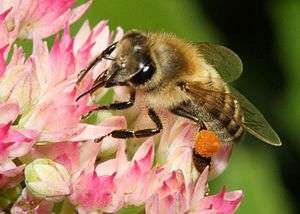Carniolan honey bee
| Carniolan honey bee | |
|---|---|
 | |
| Scientific classification | |
| Kingdom: | Animalia |
| Phylum: | Arthropoda |
| Class: | Insecta |
| Order: | Hymenoptera |
| Family: | Apidae |
| Genus: | Apis |
| Species: | A. mellifera |
| Subspecies: | A. m. carnica |
| Trinomial name | |
| Apis mellifera carnica Pollman, 1879 | |
The Carniolan honey bee (Apis mellifera carnica, Pollmann) is a subspecies of the western honey bee. The Carniolan honey bee is native to Slovenia, southern Austria, and parts of Croatia, Bosnia and Herzegovina, Serbia, Hungary, Romania, and Bulgaria.
Origin
The bee is the subspecies of the Western honey bee that has naturalized and adapted to the Kočevje (Gottschee) sub-region of Carniola (now in Slovenia), the southern part of the Austrian Alps, Dinarides region, southern Pannonian plain and the northern Balkans. These bees are known as Carniolans, or "Carnies" for short, in English. At present this subspecies is the second most popular among beekeepers (after the Italian bee).
Qualities
It is favored among beekeepers for several reasons, not the least being its ability to defend itself successfully against insect pests while at the same time being extremely gentle in its behavior toward beekeepers. These bees are particularly adept at adjusting worker population to nectar availability. It relies on these rapid adjustments of population levels to rapidly expand worker bee populations after nectar becomes available in the spring, and, again, to rapidly cut off brood production when nectar ceases to be available in quantity. It meets periods of high nectar with high worker populations and consequently stores large quantities of honey and pollen during those periods. They are resistant to some diseases and parasites that can debilitate hives of other subspecies.
Anatomy and appearance
Carniolan honey bees are about the same size as the Italian honey bee, but they are physically distinguished by their generally dusky brown-grey color that is relieved by stripes of a subdued lighter brown color. Their chitin is dark, but it is possible to find lighter colored or brown colored rings and dots on their bodies. They are also known as the "grey bee".


Carniolan bees are nearly as big and long as the Western European black bees, though their abdomens are much slimmer. Furthermore, the Carniolan bee has a very long tongue (6.5 to 6.7 mm, which is very well adapted for clover), a very high elbow joint and very short hair.[1]
Character and behavior
Strengths
- Considered to be gentle and non-aggressive
- Can be kept in populated areas
- Sense of orientation considered better than the Italian honey bee
- Less drifting of bees from one hive to a neighboring hive
- When compared to the Italian honey bee, they are not as prone to rob honey
- Able to overwinter in smaller numbers of winter bees
- Honey stores are conserved
- Able to quickly adapt to changes in the environment
- Better for areas with long winters
- Fast rhythm of brood production and then brood rearing reduction when available forage decreases
- Low use of propolis
- Resistant to brood diseases
- For areas with strong spring nectar flow and early pollination
- Forage earlier in the morning and later in the evening, and on cool, wet days
- Workers live up to 12% longer than other breeds
Weaknesses
- More prone to swarming if overcrowded
- Low ability to thrive in hot summer weather
- Strength of broodnest more dependent on availability of pollen
- Unless marked the dark queen is difficult to find

See also
| Wikimedia Commons has media related to Apis mellifera carnica. |
References
- ↑ Graham, Joe. The Hive and the Honey Bee. Hamilton/IL: Dadant & Sons; 1992; ISBN 0-915698-09-9.
- Skinner, John A. Beekeeping in Tennessee, 2004; University of Tennessee; web accessed Oct 2006
- Slovenian carnica bee breeder web page accessed Oct 2006